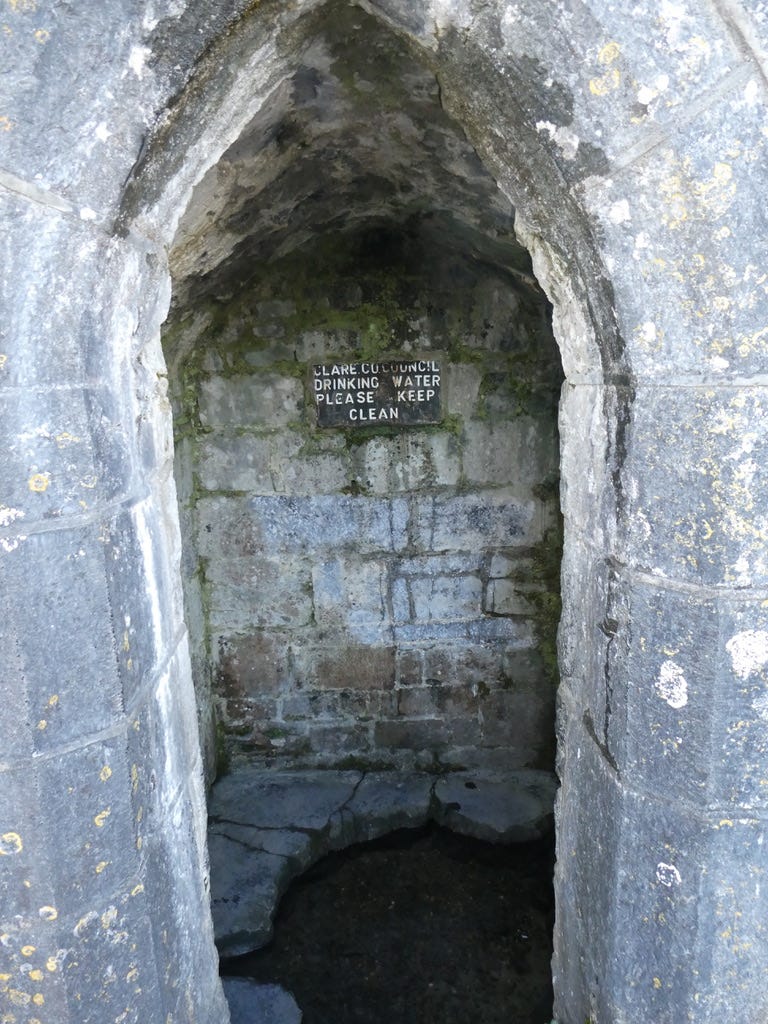The Pinnacle Well, Gleninagh, County Clare
Driving (or cycling) the coast road around the Burren, in west Clare, is always a glorious experience. The weather doesn’t matter, though in the sun it’s especially enticing:
A decade or two ago the Irish Tourist People decided to ‘brand’ all of the roads that snake along the country’s west coast, by pretending they are all one route, which they called the ‘Wild Atlantic Way’. They claim this is ‘one of the longest defined coastal routes in the world’, whatever that means, and the branding exercise has been a roaring success. You can drive the whole length of Ireland’s west coast following this signposted route with its own little logo, indulging along the way in everything from Wild Atlantic Whiskey to Wild Atlantic Coffee, staying in Wild Atlantic Guest Houses and getting stuck behind slow-moving Wild Atlantic Coaches full of tourists from America or Japan. Or, these days, tourists from India or China - Ireland is moving with the times.
Anyway, it’s a beautiful road. And if you drive the stretch through Gleninagh, south of Galway and east of Black Head, and if you’re stuck behind one of those coaches and forced to slow down and look around, you might notice an intriguing little construction by the side of the road. It looks like a tiny gothic church, but it is in fact a wellhouse, containing a spring originally known as Tobar Chornáin, but now mostly named, after its architecture, the Pinnacle Well.
This is a unique construction, I think. I’ve never seen another one like it, anyway. It was built in the 1860s by a local landlord to cover a pre-existing well. That landlord may have been the gloriously-named Bindon Blood, affectionately known as ‘the Vampire’ by admiring locals, who led what we would now call a ‘colourful life.’ Alternatively, it may have been his son, William, who was a civil engineer. Some suggest that the well was built as a folly in the grand English tradition, others that it was built to provide employment for the local poor, others that it is designed to mimic the steeple of a nearby church. The church is not very nearby, though: the well sits on the roadside under a great stone mountain and opposite the sea. There is nothing much else around apart from sheep.
Approach the entrance, and this sight will greet you:
There is a small nook built into the inside wall, apparently once used to leave offerings, but it was empty when I visited. This doesn’t appear to be an ‘active’ holy well, and there is no record of its pattern day, if it ever had one. In fact, some people argue that it was never ‘holy’ at all, but merely a water source, though records from the 1840s claim that ‘the neighbouring peasantry call it a Blessed Well.’
Who blessed it is another matter. In Irish it’s called ‘Cornan’s well’: Cornan was a very obscure early Irish saint about whom nothing is known but his name. It could also be a misspelling of the more famous name Cronan: there were at least two saints with that moniker. Alternatively, it could mean something else entirely. Pioneering travel writer Thomas Cooke wrote in the 1840s, before Blood’s spires were built over it, that ‘This well is called Tubbercornane, probably from the Irish Tobar, a spring, and Corna, a drinking cup’.
The well was apparently once used to provide drinking water for the local community, hence the weathered sign. I doubt anyone drinks from it now other than passing tourists, but the water in the pool, still refreshed by the spring, remains crystal clear:
If you’re not in the mood for water, you can always get yourself a bottle of Pinnacle Well-branded gin, made with herbs from the local mountains. Around these parts, nothing is safe from the mania for Wild Atlantic Branding.
You can follow my ‘Fifty Holy Wells’ series as it develops by clicking on the Holy Wells link on the homepage menu.









I am beginning to really look forward to these holy well visits each Sunday. It is wonderful to have something at once ancient and current to think about, the generations who brought their troubles, many more immediate and dire than even our current battles with the encroaching darkness, and went away refreshed, easier in their minds than when they came. We can vicariously visit the wells with you and come away with some of that much needed refreshment, a sense of the immanence of God and the awareness of His perpetual enchantment of the world.
I think we all need to be very careful what we read or listen to these days. I find it much easier to keep my focus on God reading things like this.
Thank you. Your writing has given me a glass through which to view the times, and now a clue as to the things I should be reflecting upon.
I love the jabs at branding. At least in Ireland it is the Wild Atlantic ... Here in New Jersey we have the aptly named “Chemical Coast”, the petro-chemical hellscape along the Arthur Kill, which separates us from Staten Island, New York. Cherish those blessed journeys through the Emerald Isle.